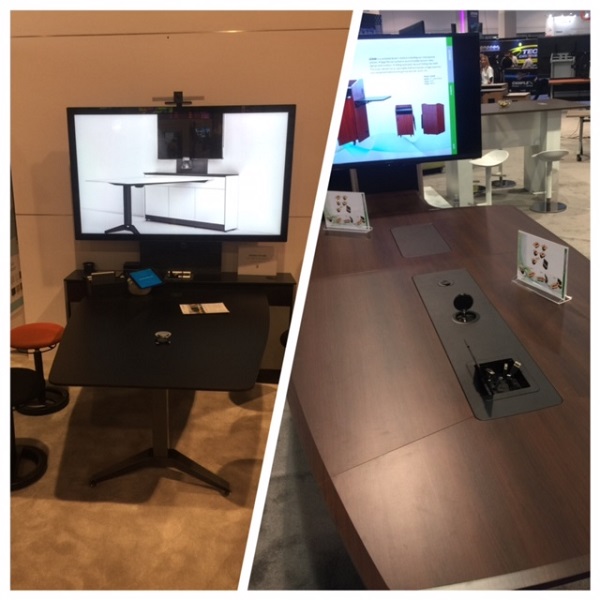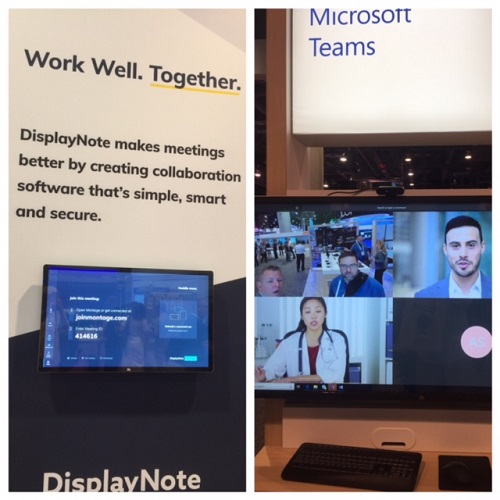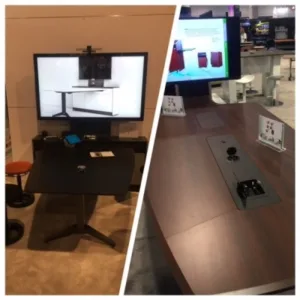As an educational technology director for decades, with a significant track record in large educational technology and AV purchases, I like to keep my ear to the ground as far as new technologies that could potentially solve some of our many pain points in the education sector. I just returned from walking every aisle of InfoComm 2018, searching for promising trends, developments, and products that might offer value for the education market.
Frankly, this year’s InfoComm—from an educator’s perspective only—largely sounded like the dog that didn’t bark. There were no blockbusters, killer educational technologies, nor grand entrances as in past years. There was little to get us to stand to our feet and applaud great educational potential. Oh well. Nevertheless, here are some of my most useful ed-market observations:
Huddle Spaces Are Ubiquitous.
Back in 2015, I surveyed the InfoComm exhibition hall and counted a little more than 20 “huddle spaces” on display. Fast forward to 2018 and huddle spaces are everywhere. And, of course, display technologies are always present in these collaborative learning settings. Not entirely new in education, the specific term “huddle space” is, in fact, relatively new. A Babylon of other terms is used to describe this instructionally powerful seating configuration in education. Steelcase calls them active learning environments; Bretford calls them teaming tables; and Smith Systems call them media tables. Other firms and educational institutions also call them lounges, hublets, coves, team gardens, collaborative learning environments, informal learning environments, learning suites, or learnlabs. But it’s all the same idea, and the idea is now officially dominating the floor.
 Some of the ubiquitous Huddle Spaces at IC18
Some of the ubiquitous Huddle Spaces at IC18
Collaboration, Integration, Management.
One strongly emerging theme, running across the exhibit Hall floor and both halls at InfoComm 2018, is the trifecta of collaboration, integration and management of display resources. The notion here is that the seamless integration of diverse technologies, the capacity to manage them with greater ease, and the ability to increase and improve collaboration in the educational enterprise are the new talking points. These three slogans – collaboration, integration, management – could be found everywhere. And I mean everywhere. Sometimes separately, sometimes combined. Sometimes identified as add-on products, sometimes as the chief offering or value proposition.
Interestingly, it appears that many hardware companies are shifting towards “collaboration, integration, management” software in their offerings, evidently a powerful new revenue stream to survive heated competition. That being said, I felt it was like a ’jungle’ on the exhibit hall. There were so many “collaboration, integration, management” solutions, so many competitors in the space, so many competing or similar claims, that it is doubtless dizzying and confusing to the educational customer.
 From Microsoft to DisplayNote, collaboration, integration and display management issues were top of mind at IC18
From Microsoft to DisplayNote, collaboration, integration and display management issues were top of mind at IC18
The Disconnects.
When reporting on the educational market, I also feel it’s quite important to identify some of the unfortunate ‘disconnects’ I observed. Here are a few:
VR. The overall VR presence was definitely muted when compared with my visit exactly two years ago.
Selling Small Tools to Large Classrooms. Having been a member of the design team for 26 newly built schools in 13 major remodels over the years, I know one thing for sure: most K 20 educational classrooms are large spaces, not small conference rooms. Yet I see manufacturers and integrators pushing display technologies for learning environments that work well in smaller rooms, but will fail to perform well given the larger distances and extreme angles more typical to the reality of the educational classroom. I can’t tell you how many times a magnificent display lost its sex appeal once I moved to acute angles and back-of-classroom distances. Perhaps the rush to sell to the huddle space has given us amnesia about the needs of larger, legacy classrooms.
Paying attention. Okay, I admit it’s a pet peeve of mine; I’ve reported on this before. In a fiercely competitive display and technology market, I still can’t understand how so many vendors can ignore their customers so often and so long with their noses buried in their cell phones. As a practicing educator I have helped a number of companies in the past, working in their booth to connect with customers, but my phone was always tucked away while I practiced the estranged art form of eye contact and customer conversation, clearly now on the decline.
 Ignoring customer ‘presence’ at IC18
Ignoring customer ‘presence’ at IC18
Hope on the Horizon.
I have to admit, however, that one particular technology did set my heart a-fluttering. Yes, those 8K LEDs are pretty amazing, isn’t it? It is so lifelike, so mesmerizing, and so visually powerful. It belongs in the classroom. After viewing delightful instances throughout the exhibit hall, I shook my head in disbelief, realizing that this technology could be truly disruptive. Let me explain. I began to wonder, “with this type of overpowering and authentic visual richness, who needs VR? Who needs 3D? Who needs holograms? Who needs legacy projection or display”? This technology may be the dragon slayer of less formidable technologies, at least in the classroom. I guess we’ll see. –Len Scrogan
Analyst Comment
Hmmm…. I think Len may have a point here. LED walls could be fantastic in classrooms, but at the moment, the difference between the cost and the resources of educators constitutes a massive barrier to adoption! (BR)

